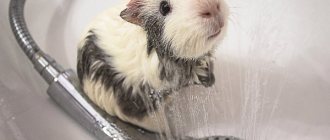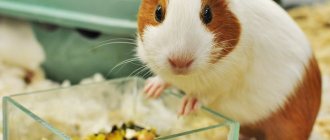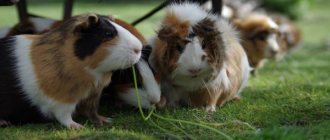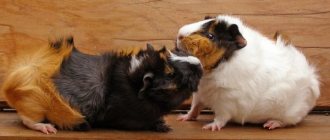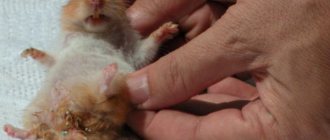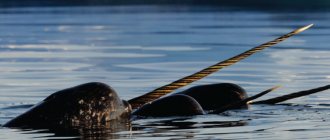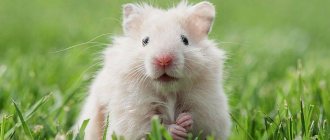Externally, the capybara is very similar to a guinea pig, only larger in size. An adult capybara can reach a length of 1-1.5. m. Males weigh 34-63 kg. Females, oddly enough, are slightly larger, their weight can reach 65.5 kg.
The capybara, despite its size, is a herbivore. The capybara has 20 teeth. No matter how many times a rodent loses cheek teeth, they quickly grow back. The rodent has short limbs. The body is covered with coarse hairs, there is no undercoat.
The capybara is found in South and Central America. It can be seen near warm shores.
The animal spends most of its time offshore, but if it is in any danger, it considers the water a safe place.
Capybaras live in groups of 10 to 20 individuals. One such family can occupy up to 10 hectares of land. Capybaras mark the boundaries of their territory.
The animals live 9-10 years, in captivity up to 12. Sometimes they are kept as pets.
The average weight of a simple domestic guinea pig usually does not exceed 0.8 kg, but in the wild it has large, similar relatives that reach 100 kg. These are the largest guinea pig in the world, called the capybara, and the giant guinea pig, the kui.
The largest guinea pigs
Characteristics of the capybara
The largest guinea pigs are not much different from the simple decorative rodents familiar to us, representing a copy enlarged several times.
External signs
In appearance and the blunt-nosed square structure of the muzzle, large wild rodents have a similar resemblance to miniature domestic ones:
- strong build, large and massive head with a blunt muzzle and widely spaced nostrils, rounded short ears, small eyes.
They grow up to 1.5 m in length, and reach 1 m at the withers. The average weight of a capybara is about 50-65 kg, but among the largest individuals there are weight record holders, gaining weight of 1 centner.
Wild rodents are distinguished by an amazing feature of the growth of their cheek teeth: when one of them falls out, a new one grows in its place. There are 20 of them in total.
The stockiness and clumsiness of the large capybara is given by the different sizes of the paws: the front ones are noticeably longer than the hind ones.
The coat is quite hard and fits tightly to the animal’s body. The coat color of a wild rodent can be red and gray, as well as in its various shades.
Geography of distribution
In its natural environment, the large wild sea capybara can be seen in the tropical regions of South America and the Andes region. Being a land rodent, it still prefers to be located near bodies of water, since if danger arises, water is the only place where the animal can hide.
Each group of large rodents is assigned its own habitat using special pheromones, where strangers are not allowed.
The animals live in small herds of 10-20 individuals with a male leader. They look for food mainly during the daytime. This is a herbivorous rodent, therefore its diet when living in natural conditions includes vegetation, including aquatic ones.
Interesting Facts
In the 16th century (according to other sources in the 17th century), the clergy of Venezuela sent a letter to the Vatican. In it they described the animal spending most of its time in water. They asked to clarify whether the meat of this semi-aquatic inhabitant can be eaten on fasting days.
In a response letter, the church leadership, to the delight of the Venezuelan people, allowed them to eat capybara meat all year round, including during fasting times, when eating fish is allowed. In addition to the capybara, the list of mammals that can be considered fish includes beavers, aquatic turtles, iguanas and muskrats.
Capybaras distinguished themselves not only in cult, but also in medical practice. They will probably make their contribution to the fight against tumor diseases in the near future. It all started with a paradox, which is based on a simple conclusion.
The larger the animal, the more cells there are in its body. Each can begin to divide uncontrollably, that is, become cancerous. This means that the likelihood of a tumor occurring in a large organism containing many cells is higher than in a small body.
In practice, such a dependence is not observed. Elephants suffer from cancer no more often than mice, and whales get sick less often than humans. This means there is control over cells with defective DNA. This phenomenon is called Peto's paradox, after the English physician who formulated the contradiction.
A special genetic mechanism has so far been discovered only in capybaras. The capybara rodent has an immune system that detects and destroys cells that are trying to become cancerous and have begun to divide uncontrollably. Capybaras, especially in old age, suffer from cancer. But in many cases, the focus of the disease is eliminated at the moment of its inception.
Keeping capybaras at home
By its temperament, a large guinea pig is quite friendly and easily makes contact with people. This explains the possibility of keeping capybaras at home. In his small homeland, the animal is often found in the homes of local exotic lovers.
In the wild, the lifespan of a large capybara is about 9 years. With good home care, capybaras can live up to 12 years.
Conditions of detention
Keeping a capybara is practically no different from keeping ordinary guinea pigs, only because of its size it requires a lot of space. They also need a cage where bowls with food, a drinking bowl with water are placed, and filler is poured. At least once a day, the capybara is allowed to roam freely.
Diet
More relatives of domestic kaviya eat the same foods: fruits, vegetables, grains, herbs and hay.
The feeding rate is calculated from the weight of the animal and is 50g per 1 kg of weight for dry food and about 70-80g per 1 kg of weight for juicy food. Hay is given in unlimited quantities and the rodent is always provided with water.
Unlike ornamental rodents, which are harmful to water procedures, wild capybaras love to swim most of all, spending a lot of time in the water. Therefore, in a private house where there is a small pool, the capybara will feel much more comfortable.
Price
These large rodents are purchased by cottage owners who want to have an exotic animal, or by owners of private zoos. It is not uncommon on the Internet to advertise that a capybara ; the price for it can reach 100 thousand or more rubles.
Before purchasing an animal, you need to make sure that there is a veterinarian within reach who has experience working with exotic rodents. Capybaras can not only bring joy, but also share some diseases or parasites with humans.
In addition to the costs of veterinary care, you will have to calculate the costs of building an enclosure and a swimming pool. During construction, it is necessary to take into account that the domestic capybara is a heat-loving animal. The least financial problems will arise when organizing the capybara's diet - its diet is simple and affordable.
Characteristics of kui
Giant guinea pigs called kui are the second large relatives of ornamental cavys, having a similar structure. Although they are called giant, they are inferior in size to large capybaras.
External signs
The average weight of a kui varies about 4 kg, and the length of the rodent grows up to 0.55 m. This is a rodent with a large head compared to the proportions of the body and large bones. Kuya's coat can be soft or hard, curly or straight, and also of different lengths. The color of the animal can be varied:
- black and white, light and dark brown, gray and piebald, golden and sand.
Geography of distribution
The giant Cui guinea pigs are native to Peru. Rodents can be found in Ecuador, Colombia and Bolivia. There they are valued as game animals due to their high-quality meat and valuable skins. Due to their high fertility, these rodents are often bred in households on a par with domestic rabbit breeding.
Indian giant squirrel
It is also called Indian ratufa . This is a tree squirrel that can be found in India. Prefers mixed or deciduous forests. These animals usually live in groups.
In each individual habitat they have their own fur color, so you can easily determine where this or that animal was caught. Usually the color scheme consists of 2-3 colors, from beige to brown in different shades, and yellow is also found. Indian giant squirrels have a white patch between their ears
The length of the squirrel, if you count the head and body, is 36 cm (adult), but they also have a long tail, which grows up to 61 cm. An adult squirrel weighs about 2 kg. They prefer to live in the upper layer of the forest. These are very cautious animals, they are active in the early morning and late afternoon.
Habitat and behavioral characteristics
In the wild, the largest guinea pig in the world is found in the tropics of South America and the Andes.
She is a direct descendant of the Guinea pig. The animal is land-dwelling, but prefers to settle closer to a body of water. Indeed, in case of danger, a river or lake is almost the only place where a capybara can hide. And she has plenty of enemies - these are wild dogs, and cat predators, and snakes, and other wild animals of the tropics.
They feed mainly during the day, but if they feel threatened or someone is bothering them, they are quite capable of searching for food at night.
They live in small groups, the “family” usually includes from 10 to 20 individuals, over which the male leader dominates. In total, there can be up to five males in the group, but anyone who encroaches on the role of leader will certainly be kicked out in disgrace by the existing boss.
Each herd is assigned its own territory, into which strangers are not allowed. They mark it with special pheromones located in the nasal and anal glands. The size of the family depends on the aridity of the area: the higher it is, the more family members there will be.
Communication in the group occurs through whistling.
Spreading
The largest rodent in the world lives in almost all countries of Central and South America, preferring a tropical, humid climate and the obligatory presence of various bodies of water - rivers, lakes, ponds. Climatic conditions, namely seasonally constant, high air and water temperatures, determine the boundaries of the animal’s living area.
The climate data below for the year in Caracas (Venezuela) is necessary for the life of capybaras.
Air and water temperatures at 0C by month, number of rainy days:
| Jan. | Feb. | March | Apr. | May | June | July | Aug. | Sep. | Oct. | Nov. | Dec. |
| 22 | 22 | 24,5 | 25,5 | 25 | 26 | 26 | 27 | 28 | 27 | 26 | 25,5 |
| 24,5 | 24 | 25 | 24,5 | 26 | 26 | 26 | 28 | 28 | 28 | 27,5 | 26,5 |
| 3 | 4 | 7 | 14 | 18 | 19 | 19 | 26 | 27 | 26 | 18 | 13 |
The water pig also feels comfortable in wooded mountains (up to 1300 m in height) and in mangrove swamps.
Don't miss the most popular article in the section: Mariana Trench on the world map. Where it is located, what makes it unique, show what’s inside.
Appearance
A large guinea pig is no different in appearance and structure from an ordinary domestic rodent; one might even say that the capybara is its copy, enlarged tenfold. On average, the length of the pet is 1.5 meters, and the height at the withers is about a meter. The average weight is 50-65 kg, females are larger than males.
The wild animal has the same blunt-nosed, almost square muzzle with widely spaced huge nostrils and puffy cheeks. The ears are set high on the top of the head, they are round and short. The eyes are located quite high, they are small and oblong. By the way, this anatomy of the sense organs is not accidental, because during bathing they will all be above the surface of the water, which will not interfere with the pig’s orientation in space.
The webbed feet resemble hooves. There is no tail. The coat is very hard and lies tightly to the body.
The legs are short, while the front legs are much longer than the hind legs, creating the feeling that the animal is about to sit down. A squat and clumsy gait on the earth's surface does not fit in with the agility and dexterity of movements in the water.
Color varies from red to gray. Life expectancy is 9-12 years.
An amazing feature of wild piglets is the constant growth of cheek teeth (there are twenty of them in total). As soon as one falls out, a new one appears in its place.
Baybak
Another name is common marmot . It lives in the virgin steppes of Eurasia. The English name “Bobak marmot” comes from the Turkic word “ baibak ”, which also means “marmot”.
It is similar to other marmots, but stands out for its yellow coloring and short tail, which does not exceed 15 cm in length. The bobak also stands out for its size: its body length is from 50 to 70 cm, a fattened male can weigh up to 10 kg.
Once upon a time it was a common animal that lived in the steppe zone from Hungary to the Irtysh. But due to the plowing of virgin lands, the amount of area it occupied was significantly reduced, because they cannot live in vegetable and grain crops. Baibaks form perennial colonies and make many burrows for themselves. They feed on plant foods.
Keeping at home
Surprisingly, the capybara is a social “personality” and gets along well with humans. Abroad, you can find this cute animal in the homes of lovers of everything unusual and exotic.
In nature, “savages” eat grass, fruits and aquatic plants. At home, they will happily eat the same foods that most ordinary domestic pigs prefer to eat.
Unlike decorative pigs, the capybara loves to swim. Water treatments are pure bliss for her, and the more often you bathe the huge rodent, the happier he will be. It is ideal to install a pool in the yard where the pig can dive from time to time. By the way, this rodent is able to hold its breath and swim underwater for up to five minutes.
Nutrition
Aquatic vegetation is the main food of capybaras. They consume succulent parts of plants: tubers, leaves, bulbs. Capybaras can dive for particularly nutritious greens. They can spend up to 5 minutes under water.
Capybaras are very selective in their diet. If any type of succulent food is present, others are completely ignored. Despite choosing the juiciest plants as food, it is difficult to digest them. To increase the number of intestinal bacteria that decompose fiber, capybaras eat their own excrement.
This method of replenishing intestinal flora, which helps digest green mass, is called autocoprophagy. In addition, capybaras often behave like ruminants. They regurgitate food they have already swallowed and chew it again. These two techniques allow you to extract the maximum amount of protein and vitamins from greens.
Like any herbivores, capybaras devastate plantings of sugar cane, corn, and other grains, and can damage melon plantings. Farmers don’t really like this, and capybaras, as pests, are often shot. Besides humans, capybaras can be attacked by almost any predator.
Mara
They are also called Patagonian hares or Patagonian pigs . Mara can grow up to 69-75 cm, large individuals gain weight up to 9-16 kg. Their tail is only 4.5 cm long.
The upper part of their body is grayish, the lower part is whitish, and there are white or yellow stripes on the sides. This rodent has thick fur.
You can meet mara in South America. They prefer to go out in search of food during the day, gather for communal feeding, and feed on plants.
Flanders
This is the name of one of the rabbit breeds. She was bred in Belgium. Flanders is one of the most famous and widespread breeds; exactly how it was obtained is not known exactly.
These rabbits are bred in many countries, and in each of them Flanders have their own characteristics. There are German, English, Spanish, etc. representatives of this breed. They did not take root in the USSR due to the harsh climate, but were used to breed the “gray giant” breed.
Flanders amazes with its size. They have a long body - up to 67 cm, high, thick and dense fur, color - gray or yellow-gray. Adult rabbits weigh 7 kg, some of them grow up to 10-12 kg, there are record holders weighing 25 kg.
Crested porcupine
It is often called the porcupine . The thick and stocky body of the animal is covered with dark and white needles. He has 2 types. There are long and flexible ones, growing up to 40 cm, and there are short and hard ones, 15-30 cm each, but differing in significant thickness.
The crested porcupine has a rounded muzzle with round eyes. He has short legs, he moves slowly, but he can also run. He uses his voice very rarely, only in moments of danger or irritation.
This is a very large rodent, growing up to 90 cm, plus a tail of 10-15 cm. Average weight is 8-12 kg, but some well-fed males weigh up to 27 kg.

